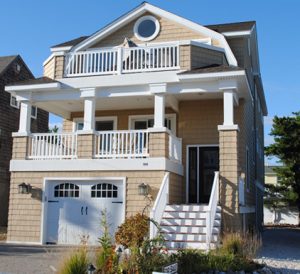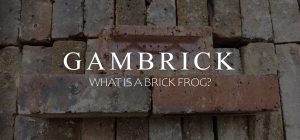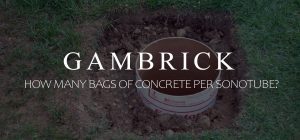
The Best Concrete Mix For Footings
Concrete footings are the lowest part of a structure’s foundation. That could be a home, building, bridge, deck, or even a dam. The footing is made from solid concrete and supports the weight of the entire structure built atop it. They sit below ground and typically have rebar inside to give them strength. The concrete used to build footings has to be very strong or else the weight placed on top could crack them and compromise the structure. The strength of concrete is measured in psi or pounds per square inch. Typically a footing should be at least 3500 psi.
To make a 3500 psi footing mix, add 1 part Portland cement, 2 parts sand and 4 parts stone aggregate by volume. Add in 3 quarts water per 80 pounds of dry concrete. Aggregate should be between 1/2 – 1 inch in size.
Professional grade concrete mixes can have compressive strength levels much higher than 3500 psi. Some go as high as 10,000. This is achieved by adjusting the ratios and ingredients used. More and larger stone aggregate produces a stronger concrete.
Attributes like crack and shrinkage resistance, fast setting or even more strength can be achieved by using additives. This could be physical additives like micro rebar and fiber or chemicals.
Footings are one of the most important part of any structure. The entire structure is built on top of them, so if they’re not strong enough to support the load, the structure will fail. Because of how important they are it’s very important to be sure your concrete mix is right for whatever your building.
Below are some important things to consider when choosing the best concrete mix for your footings.

Footings And Foundations
Most construction projects begin with the footings. Regardless of the size or complexity of the structure being built, the foundation is almost always built first. And the first, and probably the most important part of a foundation, is the footing. And even though the footing is considered a part of the foundation, they’re different.
Footings are the lowest part of the building. Typically they’re a large concrete mass with rebar inside that’s designed to support the entire load of what’s built above. If that’s a residential home, then all the weight of the entire house rests atop the footing. This is also true of large scale projects like buildings, bridges and even dams. But it’s also true of smaller projects like a deck or shed. If you need to support a large load, chances are you’ll have a concrete footing.
Footings are the lowest part of the foundation and generally sit atop excavated and compacted soil or rock. The weight of what’s built on top is transferred from the footing onto the Earth below.
The concrete mix used for your footing has to formulated to support the load of what’s being built. Obviously the same concrete that’s used for a bridge footing wouldn’t be needed to support a deck. On average, the typical residential footing has a psi rating of between 3500 – 4000 psi. That’s very strong concrete but not strong enough for most large scale commercial or industrial projects.
Both the foundation and the footing play an important role in building a structure. They work together to support the weight of whatever being built. The footing supports the foundation that supports the walls and beams that supports the roof. The weight of the structure is transferred downward until ultimately it all rests on the footing.
Compressive Strength
A footing is designed to carry a very heavy load which is called compressive strength. This is measured in psi or pounds per square inch. When you look at a bag of 3500 Quikrete premixed concrete. The 3500 means 3500 psi. If you put more pressure on the concrete than it’s designed to bear, it can crack. It’s important to note that 3500 psi will be achieved at 28 days after full curing is completed. At 10 days, the concrete mix will only be about 1500 psi.
Knowing and understanding your concrete mix’s compressive strength is very important to building a strong footing. Answering what’s the best concrete mix for footings has a lot to do with how much weight that footing will carry. Quikrete bagged concrete and concrete from a truck will come with documentation that details the mix’s potential compressive strength. If your mixing your own concrete then research a formula that meets the requirements your footings need. Those requirements will be detailed on the blueprints.
For example, a set of blueprints may say the footing is 36 inches deep x 24 inches wide x 12 inches thick with #4 rebar and 3500 psi concrete at 28 days.
Most experts recommend that for residential footings, the psi should be at least 3,500 to 5,000. The larger and heavier the structure, the higher the psi will be needed to support it. Deciding which concrete is best to use for your footing should be done in the design phases of the project and not during construction.
There are ways to increase a concrete mix’s compressive strength. Using more and larger aggregate stones is one way to do it but another are additives and stronger cement. You can also vary the water-cement ratio. Less water typically means stronger concrete.
Aggregate
Choosing the best concrete mix for your footings has a lot to do with the aggregate. Aggregate is the stone and sand used in the concrete mix. Cement is the active binding agent that reacts with water and hardens the concrete. But it’s the aggregate that gives it strength. It’s also the largest component and makes up the bulk or mass of the concrete. Aggregate levels and size add to the overall compressive strength of the concrete. The more stone you use the stronger the concrete mix will be. The same is true as the aggregate gets larger.
Aggregates are materials such as sand, gravel, or crushed stone that, along with water and Portland Cement, make concrete.
Footings typically have rebar to strengthen and reinforce the concrete. Using aggregates that are too coarse or large can cause a problem called “honeycombing.” This is caused in concrete by using the incorrect grade or size aggregate in the mixture or by mixing incorrectly.
Honeycombing happens when aggregate is too large or course and sits against rebar creating voids that resemble a honeycomb. These voids weaken the concrete and can lead to cracks. They also reduce the compressive strength of the concrete.
You can correct honeycombing by adding more cement and fine aggregates like sand or small smooth stones into the mix and by mixing the concrete properly.
In general, most residential concrete footing mixes use sand and stone aggregate that’s between 1/2 inch -1 inch in size.
Consistency
Checking your concrete’s consistency before you pour it into the footing form is very important. Water is a critical part of making strong concrete that will achieve it’s maximum psi rating. Too much water and the concrete will be weak. Too little, and it will be brittle and weak.
The way to determine if the correct amount of water was used is to check it’s consistency. In general, 3 quarts of water are used per 80 pounds of dry concrete. This is pretty universal no matter the strength of the concrete. However you should vary the water level as needed if your using additives or stronger cement.
Once you add the water and mix the concrete thoroughly, you can perform a very simple test. Take the concrete in your hand and form it into a ball. It should have the consistency of thick oatmeal and should hold form like a snowball. The cement should be sticky like a paste.
- If the concrete is too soft to hold form and feels like a soup, you used too much water. In this case add in more dry mix until you get the correct consistency.
- If the mix has dry spots with concrete powder, you need to add more water. Mix in water slowly until there’s no dry concrete left.
Using less water generally makes the concrete stronger. But you need enough to thoroughly mix it and to use up all the dry concrete.
How To Make Concrete For Footings
The best concrete mix for footings is actually pretty easy to make. It’s 1 part Portland cement, 2 parts sand and 4 parts stone aggregate by volume. Add in 3 quarts water per 80 pounds of dry concrete. Aggregate should be between 1/2 – 1 inch in size.
That’s it. Concrete is a fantastic building material that’s very easy to make. The formula above will yield around a 3500 psi concrete at 28 days curing time. If you need a stronger concrete, use more or larger aggregate stones or consider an additive.
Quikrete makes some of the best pre-mixed concrete for footings. They come in 60 or 80 pound bags and are ready to go. Just add water. The strength varies from 3500 to 5000 psi which makes them strong enough for almost any footing.
Sakrete is another popular manufacturer of pre-mixed concrete that’s very similar to Quikrete.
Whether your mixing your own concrete or buying it in bags, water is the most important element because that’s up to you. Make sure to use just enough but not too much.
If your buying concrete from a truck then let them know exactly the strength you need. They’ll do all the figuring for you at the plant including the water levels. Make sure they don’t add any water to the mix on site. Many novice masons or lazy concrete truck drivers will spray the shoots with water to make the concrete flow better. This makes work easier but weakens the concrete and your footings.
Breakdown
Here’s a few quick tips and general info to consider when choosing the best concrete mix for your footings.
- Quikrete & Sakrete bagged concrete comes in strengths between 3500 – 5000 psi which is more than enough for most residential footings.
- If your mixing your own concrete, search online for a formula that makes the strength you need. The basic recipe we’ve detailed above and below creates 3500 psi concrete.
- To make the basic mix, add 1 part Portland cement, 2 parts sand and 4 parts stone aggregate by volume. Add in 3 quarts water per 80 pounds of dry concrete. Aggregate should be between 1/2 – 1 inch in size.
- Make sure you pay careful attention to the water level. 3 quarts per 80 pounds is about right.
- Don’t let concrete truck drivers add water on site to the shoot. It will weaken the concrete and your footing.
- Additives are a great way to strengthen your concrete without adjusting the aggregate.
- Footings support the structure your building. Match the psi rating to the weight of what your building. This will be determined by the architect or engineer.
Summary: The Best Concrete Mix For Footings
Footings are the lowest part of a structure’s foundation. That could be a home, building, bridge, deck, or even a dam. The footing is made from solid concrete and supports the weight of the entire structure built atop it. They sit below the ground and typically have rebar inside to add even more strength. The concrete used to build footings has to be very strong or else the weight placed on top could crack them and compromise the structure. The strength of concrete is measured in psi or pounds per square inch. Typically a footing should be at least 3500 psi. To make the mix, add 1 part Portland cement, 2 parts sand and 4 parts stone aggregate by volume. Add in 3 quarts water per 80 pounds of dry concrete. Aggregate should be between 1/2 – 1 inch in size.
Professional grade concrete mixes can have compressive strength levels high above 3500 psi. Some go as high as 10,000. This is achieved by adjusting the ratios and ingredients used. More and larger stone aggregate produces a stronger concrete. Attributes like crack and shrinkage resistance, fast setting or even more strength can be achieved by using additives. This could be physical additives like micro rebar and fiber or chemicals.
Footings are one of the most important part of any structure. The entire structure is built on top of them, so if they’re not strong enough to support the load, the structure will fail. Because of how important they are it’s very important to be sure your concrete mix is right for whatever your building.
If you have any questions or comments e-mail us any time. We’d love to hear from you.

John Mazzuca | About | More Posts |
Custom Home Builder
John Mazzuca is a custom home designer and builder at Gambrick with over 25 years experience in the construction industry. John has designed, built and/or remodeled hundreds of homes, small buildings, and commercial projects. He writes about business, real estate, home building, and household electronics. His work has been featured in Fox Business, Better Homes & Garden, House Beautiful, and more.




















